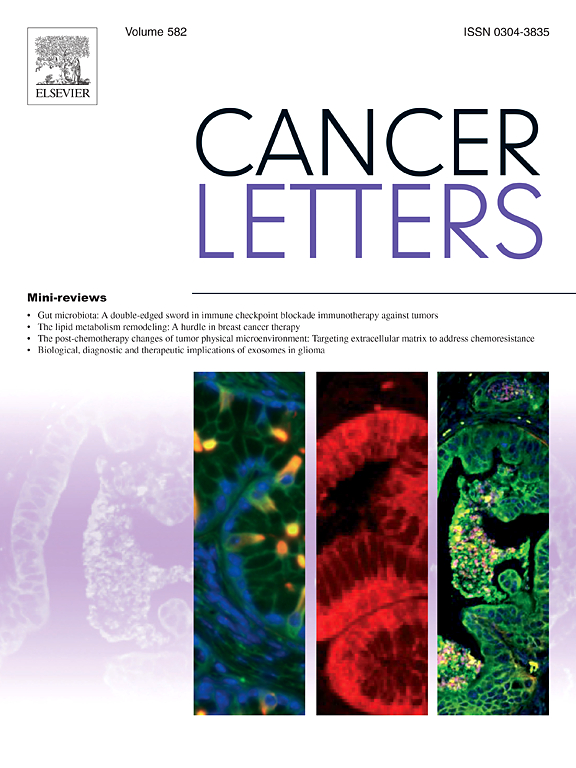Unraveling the molecular mechanism underlying the anticancer activity of CISD2/NAF-144−67
IF 9.1
1区 医学
Q1 ONCOLOGY
引用次数: 0
Abstract
We recently reported on the development of a unique cancer-targeting peptide called NAF-144−67 (derived from CISD2/NAF-1). NAF-144−67 selectively permeates the plasma membrane (PM) of cancer cells, but not healthy cells, causing the activation of apoptotic and ferroptotic cell death pathways specifically in cancer cells. NAF-144−67 also targets and shrinks human breast and ovarian cancer tumors in a xenograft mice model system without any apparent side effects. Although the specific permeation of NAF-144−67 through cancer cell PMs was studied, and its cancer killing effects validated in vitro and in vivo, little is known about how NAF-144−67 exerts its biological activity once it enters cancer cells. Here, we report that NAF-144−67 targets the CISD2/NAF-1 protein of cancer cells and disrupts its homodimeric structure. We further reveal that a peptide derived from the same domain of the human CISD1 (mitoNEET; mNT19-42) protein, a close family member to CISD2, has no killing activity towards cancer cells, and that dimers of NAF-144−67 (at two different orientations) have higher anticancer activity compared to monomeric NAF-144−67. Our findings shed new light on the biological activity of NAF-144−67 and bring it closer to becoming a potential new anticancer drug.
揭示CISD2/ naf144 -67抗癌活性的分子机制。
我们最近报道了一种独特的癌症靶向肽的开发,称为naf144 -67(源自CISD2/ naf1)。naf144 -67选择性地渗透到癌细胞的质膜(PM),而不是健康细胞,导致癌细胞中凋亡和铁细胞死亡途径的激活。在异种移植小鼠模型系统中,naf144 -67还能靶向和缩小人类乳腺癌和卵巢癌肿瘤,没有任何明显的副作用。虽然研究了naf144 -67通过癌细胞pm的特异性渗透,并在体外和体内验证了其杀癌作用,但对于naf144 -67进入癌细胞后如何发挥其生物活性知之甚少。在这里,我们报道了naf144 -67靶向癌细胞的CISD2/ naf1蛋白并破坏其同型二聚体结构。我们进一步揭示了来自人类CISD1相同结构域的肽(mitoNEET;mNT19-42)蛋白是CISD2的近亲,对癌细胞没有杀伤活性,naf144 -67的二聚体(两种不同取向)比单体naf144 -67具有更高的抗癌活性。我们的发现揭示了naf144 -67的生物活性,使其更接近成为一种潜在的新型抗癌药物。
本文章由计算机程序翻译,如有差异,请以英文原文为准。
求助全文
约1分钟内获得全文
求助全文
来源期刊

Cancer letters
医学-肿瘤学
CiteScore
17.70
自引率
2.10%
发文量
427
审稿时长
15 days
期刊介绍:
Cancer Letters is a reputable international journal that serves as a platform for significant and original contributions in cancer research. The journal welcomes both full-length articles and Mini Reviews in the wide-ranging field of basic and translational oncology. Furthermore, it frequently presents Special Issues that shed light on current and topical areas in cancer research.
Cancer Letters is highly interested in various fundamental aspects that can cater to a diverse readership. These areas include the molecular genetics and cell biology of cancer, radiation biology, molecular pathology, hormones and cancer, viral oncology, metastasis, and chemoprevention. The journal actively focuses on experimental therapeutics, particularly the advancement of targeted therapies for personalized cancer medicine, such as metronomic chemotherapy.
By publishing groundbreaking research and promoting advancements in cancer treatments, Cancer Letters aims to actively contribute to the fight against cancer and the improvement of patient outcomes.
 求助内容:
求助内容: 应助结果提醒方式:
应助结果提醒方式:


